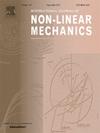摩擦自激振动下花键转子系统的稳定性分析
IF 2.8
3区 工程技术
Q2 MECHANICS
International Journal of Non-Linear Mechanics
Pub Date : 2025-04-17
DOI:10.1016/j.ijnonlinmec.2025.105127
引用次数: 0
摘要
花键连接会产生交叉耦合、内摩擦和界面不连续性,在某些运行条件下会导致系统不稳定和自激振动。预测花键转子系统自激振动的起始条件和振幅,以及它们与错位和界面摩擦等物理参数的关系,对于有效的设计工作至关重要。因此,本研究对受到界面摩擦引起的自激振动影响的花键转子系统进行了全面的稳定性分析。首先,采用复特征值法确定平衡点稳定性。然后,应用数值延续方法进行全局稳定性评估,并快速预测极限循环。为了提高计算效率,还结合了模型还原法,从而系统地研究了参数对系统稳定性和振动响应的影响,阐明了摩擦机理和影响规律。通过这项深入研究,揭示了受自激振动影响的花键转子系统的稳定性和非线性行为,为减轻旋转机械系统不稳定性和自激振动的有效设计策略提供了重要的理论支持。本文章由计算机程序翻译,如有差异,请以英文原文为准。
Stability analysis of a spline-rotor system subjected to friction-induced self-excited vibrations
Spline joints introduce cross-coupling, internal friction, and interface discontinuities, that can lead to system instability and self-excited vibrations under certain operating conditions. Predicting the onset conditions and amplitudes of self-excited vibrations in the spline-rotor system, as well as their dependence on physical parameters such as misalignment and interfacial friction, is crucial for effective design work. Therefore, in this study, a comprehensive stability analysis of a spline-rotor system subjected to self-excited vibrations induced by interfacial friction is carried out. First, the complex eigenvalue method is used to identify the equilibrium point stability. Then, numerical continuation methods are applied to perform a global stability assessment and to rapidly predict limit cycles. To improve computational efficiency, model reduction is integrated, which allows a systematic investigation of the effects of parameters on system stability and vibration response, elucidating the friction mechanism and influence laws. Through this in-depth study, the stability and nonlinear behavior of the spline rotor system subjected to self-excited vibration is revealed, providing crucial theoretical support for effective design strategies to mitigate system instability and self-excited vibration in rotating machinery.
求助全文
通过发布文献求助,成功后即可免费获取论文全文。
去求助
来源期刊
CiteScore
5.50
自引率
9.40%
发文量
192
审稿时长
67 days
期刊介绍:
The International Journal of Non-Linear Mechanics provides a specific medium for dissemination of high-quality research results in the various areas of theoretical, applied, and experimental mechanics of solids, fluids, structures, and systems where the phenomena are inherently non-linear.
The journal brings together original results in non-linear problems in elasticity, plasticity, dynamics, vibrations, wave-propagation, rheology, fluid-structure interaction systems, stability, biomechanics, micro- and nano-structures, materials, metamaterials, and in other diverse areas.
Papers may be analytical, computational or experimental in nature. Treatments of non-linear differential equations wherein solutions and properties of solutions are emphasized but physical aspects are not adequately relevant, will not be considered for possible publication. Both deterministic and stochastic approaches are fostered. Contributions pertaining to both established and emerging fields are encouraged.

 求助内容:
求助内容: 应助结果提醒方式:
应助结果提醒方式:


